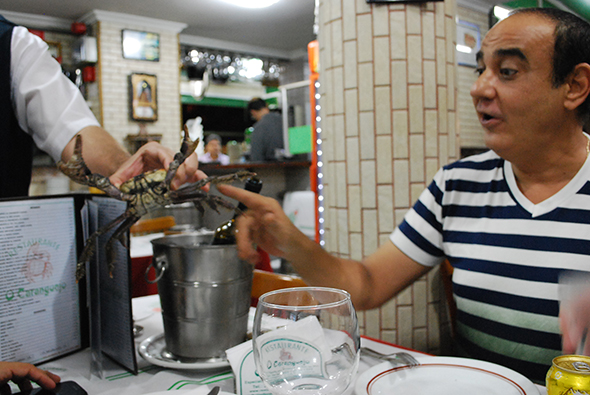
Eugenio Valdés Figueroa. Restaurante Caranguejo, April 6th, Rio de Janeiro, 2015. Photo: Jessica Gogan
Crabs, Butterflies, Enigmas, and Banquets
A conversation with Eugenio Valdés Figueroa
Plato in “The Banquet” said: all activity that determines the passage from not being into being is poiesis.1 Heidegger, the modern philosopher, refers to it as illumination in its broadest sense. Of poiesis comes poetry, which is magic, play, transformation. Poiesis is a form of wisdom and knowledge – any creative process, cheerful, playful and alive. The Greeks knew that the ideal place to talk about key issues was in the midst of a great feast, eating and drinking with close friends. Crabs and butterflies is an expression of this idea. Eugenio Valdés Figueroa, with a finely tuned intuition, here imagines a creative and critical tool to think about art and education, via a crab dinner.
– Eugenio, what’s the story behind the crab dinner?
The idea of organizing a debate on art during a crab feast has captivated me for almost a decade. I had recently arrived in Rio de Janeiro and Daros Latin America had already begun to look for a property to host Casa Daros, a new Latin American contemporary art center in the city, which I had been developing together with the curator Hans-Michael Herzog. It had not yet left the paper stage.2 However, those first well-thought-out curatorial writings that we conceived of together acted as our compass.
On this visit Daros Latin America’s librarian in Zurich, Regina Vogel accompanied me. She and I had been carrying out research on libraries and contemporary art archives throughout Europe and Latin America. One day we went to lunch with Márcio Botner, artist, art professor at Parque Lage (School of Visual Arts) and co-founder, with the artists Ernesto Neto and Laura Lima, of the Rio gallery Gentil Carioca.
– What year was that?
It was in 2004. Márcio had invited Regina and myself for lunch at a place specializing in crabs. It was a special time; we were in the process of seeking a “home” for the Casa Daros project; we were full of dreams, utopias and had an enormous desire to start working. When we got to the restaurant we were given aprons, hammers and wooden planks. As we de-shelled the crabs that arrived in a succulent sauce, spontaneous good humor among friends mingled with pointed reflections on the contemporary art scene in Brazil and Latin America.
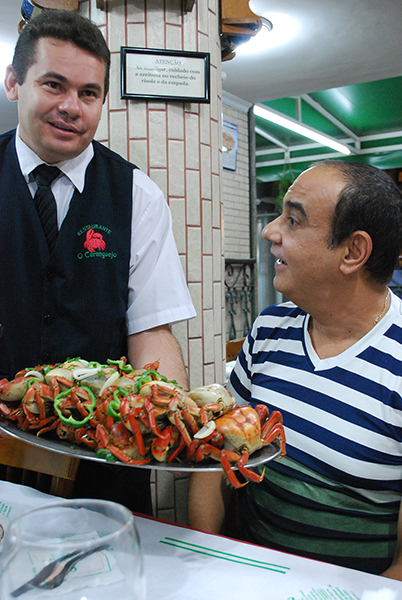
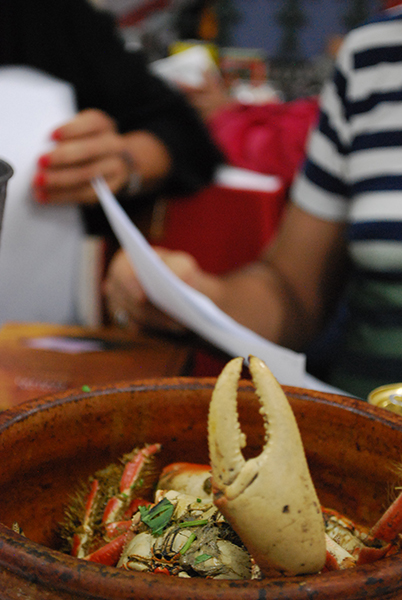
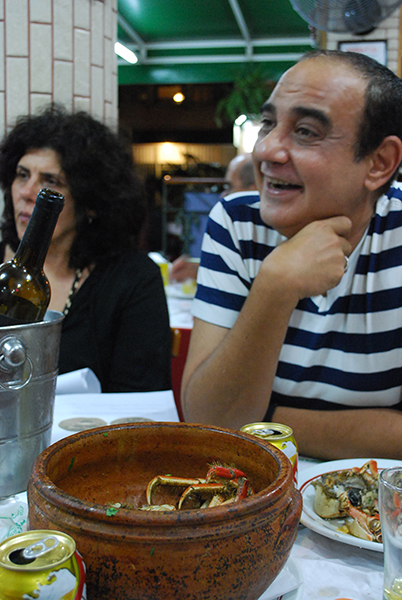
Eugenio Valdés Figueroa. Restaurante Caranguejo, Apri 6th, Rio de Janeiro, 2015. Photos: Jessica Gogan
It has always seemed to me that to eat crab is in itself a spectacle. While you talk to someone, you hammer the crab, and with every impact sauce flies everywhere. It’s fun, even hilarious, and at the same time violent. I remember the three of us laughed at the situation, of being there speaking about art, making diagnoses, issuing judgments on the Latin American art scene and what it needed, all the while hammering away to get at the crab. The intensity of the hammering varied with the passion we put into what we were saying. At that very moment I had an idea that I shared instantly with the others, one that I still have: use a less conventional setting to make “diagnostics” on the current art situation contrary to the format that symposia and seminars usually have.
I found it very interesting that one day we might be able to bring together professionals from the world of art and artists to discuss key issues based on the real needs of the Latin American situation, and to do it during a crab dinner. All seated at a table talking, planning activities and issuing positions on art as we hammered crabs. It would be a delicious sensory experience, but would require a lot of planning!
– It is common in Latin America to say that we walk “backwards like the crab” when we cannot seem to move forward with our objectives…
Yes, the idea of hammering away at what symbolizes walking backwards also seemed provocative; it was above all another way of making a point. I find that very important. Throughout my career, in my experience the best discussions arise between committed friends during a lunch or having a few drinks. These passionate encounters decide many important things. Many of the ideas that today constitute the philosophy of Casa Daros were discussed and written in this way, among friends, during passionate discussions, with full transparency and confidence, convinced that to go against the grain is possible and necessary.
– How then did the ‘encounter’ of crabs and butterflies come about?

Eugenio Valdés Figuera and Luiz Guilherme Vergara. Restaurante Caranguejo, April 6th, Rio de Janeiro, 2015. Photo: Jessica Gogan
After settling in Rio, I met Luiz Guilherme Vergara, a professional whom I admire and respect greatly, with whom I share a high degree of affinity when we talk about our ideas and hopes particularly with respect to the relationship between art and pedagogy. Luiz Guilherme has done an extraordinary job at MAC (Museum of Contemporary Art) Niterói and also at Instituto MESA, along with Jessica Gogan.
At one point, after Luiz and Jessica presented the work and ideas of MESA Institute, we spoke about the possibility of doing a seminar on education, and I told them about this old idea that I had not been able to realize: the crab dinner. Ever since that first conversation, we’d planned to organize the dinner many times, but it didn’t happen. One day we were on the verge of doing it, but found it coincided with a period banning crab fishing and we could not find crabs in Rio de Janeiro. After repeated attempts, we began to realize that it was more of a “conceptual” project. We had a great idea and that was enough, we preferred not to insist on doing it.
– What was your experience in Cuba with crabs, and how do you relate this to education?
When I was younger, I followed the adults in my family on crab hunts. In Cuba these are not at sea, but along the roads by the sea. We would leave at dawn in a jeep with flashlights and reflectors.
When you cast light on crabs that are caught off guard in the darkness, they are immediately immobilized, and this is the time to capture them. In this type of hunt there is a kind of beautiful care required, which is not to pull off the crabs’ legs, only their claws because these regenerate over time. After these are plucked, the crabs are released. They run, hide in a hole and wait until their claws grow again. If you snatch their legs, you condemn them to death. This story intrigued me in that the crab that walks backwards should be immobilized by light. This lent itself to many analogies and metaphors.
Another one of my obsessions is the book Blindness by José Saramago. The novel begins when someone waiting in his car for the traffic light to change, is suddenly blinded, blocking traffic and causing confusion. It was a white blindness that throughout the novel spreads reaching epidemic proportions. Excess light saturation – this white blindness – is comparable to the information overload we are subjected to in contemporary times. It is increasingly difficult to distinguish the details, the intricacies of information, the matrixes, and contrasts. It is an issue that troubles me today: how information is distributed among young people, and how difficult it is to really process that information.
The excess of information becomes violent when we are not allowed to understand what we see. Visual production has become a lucrative market where economic issues often supersede ethical and moral questions. It is necessary to maintain a distance from the world of visibilities so that we don’t lose our discernment and our critical perspective, because otherwise we can be “swallowed” by the image.
So one of the challenges of contemporary pedagogy is to try to get young people to stop amidst the velocity of the world, to slow down their habits of time, which are much faster than people of my generation, so that they can immerse themselves in information, put limits on it, understand it well, and issue opinions. That is, instead of just consuming it, they can return information to the world with a newly added criterion of value; and in this way they may affect the production of information based on this criterion of value.
The history of the crab is complex and useful to poeticize and ‘metaphorize’ regarding fundamental questions about education: we can think of young people as individuals that, being caught off guard, can be blinded with an excess of light. I want them to stop and think. I put this and other issues on the table when I spoke to Luiz Guilherme Vergara and Jessica Gogan.
– And the butterflies?
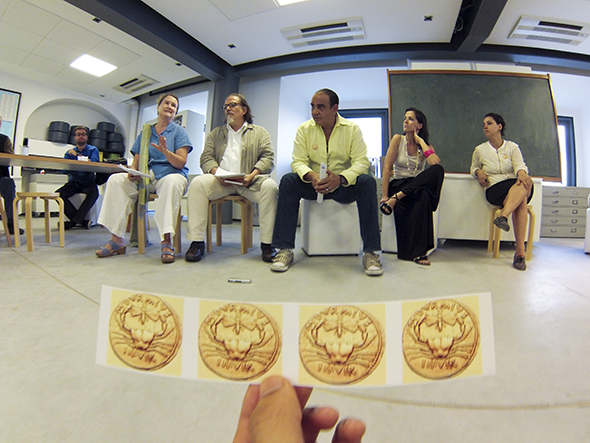
From left to right: Jessica Gogan, Luiz Guilherme Vergara, Eugenio Valdés Figueroa, Bia Jabor and Roberta Condeixa. Regional encounter, Publicness in Art: Crabs & Butterflies, September 28th, 2013, Casa Daros. Photo: Delmar Mavignier
To continue the connection with the literature on crabs, Jessica brought an incredible image of an old coin on which is minted the image of a crab with a butterfly. The idea of the metamorphosis of the crab as a butterfly was totally enigmatic. Enigma is very important, both in education and in art. If art and education ceased to produce questions and enigmas, they would cease to be what they are. A response should always lead to other questions. The crab and the butterfly consolidated a theme and an image: that the starting point of a series of seminars, meetings and reflections on education should be beyond dead theory; it should be poetry and metaphor. I think this should be the desire of all who work with education.
Eugenio Valdés Figueroa is an independent curator and critic focusing on Latin American art and was former director of art and education at Casa Daros. This interview is edited and transcribed from a conversation with the researcher Felipe Moreno at Casa Daros, September 5th, 2014.
_
1 “The Banquet” or “The Symposium” is one of Plato’s dialogues focusing on love composed around 380 AC. For overview and additional links. (Accessed January 2015)
2 Casa Daros was officially inaugurated in March 2013



